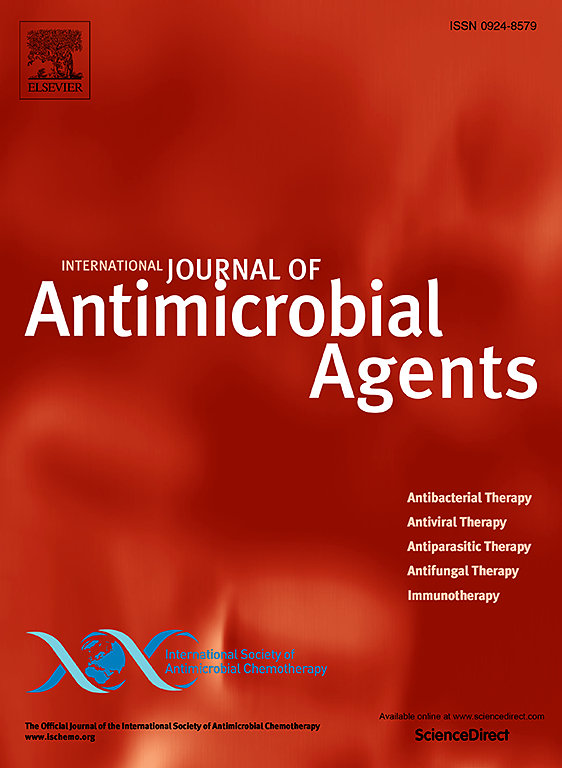Antimicrobial resistance trends, predictors, and burden in England: a retrospective study using the Clinical Practice Research Datalink from 2015 to 2021
IF 4.6
2区 医学
Q1 INFECTIOUS DISEASES
International Journal of Antimicrobial Agents
Pub Date : 2025-05-13
DOI:10.1016/j.ijantimicag.2025.107535
引用次数: 0
Abstract
Objectives
Evidence describing the burden of antimicrobial resistance (AMR) to health care systems is essential to inform health care policy to tackle AMR. This study aims to investigate trends, predictors, and clinical and economic burden of AMR within the English National Health Service.
Methods
We conducted a retrospective cohort study assessing 1,036,850 patients diagnosed with an infection as a hospital inpatient linked to the Clinical Practice Research Datalink within England between 2015 and 2021. Resistance was identified with specific International Classification of Diseases, 10th revision, codes. Predictors of AMR were determined using logistic regression and extreme gradient boosting trees. A 1:1 propensity score matched cohort of 78,153 patients with an AMR infection compared with those without was created. Incidence rate ratios were estimated between those 2 groups for hospital length of stay (from admission to discharge), rehospitalisations within 1 year of diagnosis of infection, and total hospital costs. Acceleration factors were estimated for time to all-cause mortality and first rehospitalisation.
Results
Between 2015 and 2020, AMR had a proportional increase of 10%. Resistant infections are associated with an additional 9.2 days length of stay and an additional hospitalisation cost of £3441 per patient compared with infections not reported as resistant. Within 1, 3, and 5 years 3.2%, 6.3%, and 7.3% more patients with AMR infections died and 7.8%, 5.3%, and 3.6% more patients were rehospitalised, respectively. Acceleration factors indicated patients with AMR infections die 27% earlier and rehospitalised 26% earlier than those with non-AMR infections.
Conclusion
AMR is a significant and growing threat to health care; this analysis suggests that AMR is associated with significant excess of health care use and increased mortality and readmission.
英国抗菌素耐药性趋势、预测因素和负担:2015-2021年临床实践研究数据链的回顾性研究
目的:描述抗微生物药物耐药性(AMR)给卫生保健系统带来的负担的证据,对于告知卫生保健政策以应对AMR至关重要。本研究旨在调查趋势,预测因素,临床和经济负担的抗菌素耐药性在英国国家卫生服务。方法:回顾性队列研究评估了2015年至2021年期间与英国临床实践研究数据链相关的1,036,850名被诊断为感染的住院患者。用特定的ICD-10编码鉴定耐药性。使用逻辑回归和极端梯度增强树确定AMR的预测因子。与没有AMR感染的患者相比,创建了一个1:1倾向评分匹配的78153例AMR感染患者队列。对两组住院时间(从入院到出院)、诊断感染后1年内再次住院以及总住院费用的发生率比(IRRs)进行了估计。估计加速因子(AFs)的时间到全因死亡率和首次再住院。结果:2015 - 2020年,AMR呈10%的比例增长。与未报告为耐药的感染相比,耐药感染与每名患者额外9.2天的住院时间和3,441英镑的额外住院费用有关。在1、3和5年内,AMR感染患者的死亡率分别增加3.2%、6.3%和7.3%,再次住院的患者分别增加7.8%、5.3%和3.6%。AFs显示,AMR感染患者比非AMR感染患者早27%死亡,再住院时间早26%。结论:AMR是对医疗保健的重大且日益增长的威胁;这一分析表明,AMR与医疗保健使用的显著过度以及死亡率和再入院率的增加有关。
本文章由计算机程序翻译,如有差异,请以英文原文为准。
求助全文
约1分钟内获得全文
求助全文
来源期刊
CiteScore
21.60
自引率
0.90%
发文量
176
审稿时长
36 days
期刊介绍:
The International Journal of Antimicrobial Agents is a peer-reviewed publication offering comprehensive and current reference information on the physical, pharmacological, in vitro, and clinical properties of individual antimicrobial agents, covering antiviral, antiparasitic, antibacterial, and antifungal agents. The journal not only communicates new trends and developments through authoritative review articles but also addresses the critical issue of antimicrobial resistance, both in hospital and community settings. Published content includes solicited reviews by leading experts and high-quality original research papers in the specified fields.

 求助内容:
求助内容: 应助结果提醒方式:
应助结果提醒方式:


